Submitted:
08 February 2024
Posted:
08 February 2024
You are already at the latest version
Abstract
Keywords:
1. Introduction
2. Study area
3. Data
3.1. DMSP Night Lights Data
4. Methods
4.1. Processing of the DMSP Night Lights (2000-2013)
4.2. Processing of the LandScan Global Population Data
4.3. Presence or Absence of Night Lights across the Basin and Buffer Zones
4.4. Night Light Intensity Distribution with Relation to River Channel Pattern
5. Results
5.1. How Well Do Night Light Data Serve as a Proxy for Human Activity?
5.2. Relation between Night Light Distribution and Proximity to Rivers
5.3. How Does the Intensity of Night Lights Vary in Proximity to Rivers?
5.4. Channel Pattern Influence on Human Presence
6. Discussion
6.1. What Do Night Lights Reveal about Human Presence and Activity in the Indus Basin?
6.2. What Is the Relation between Geomorphological Parameters and Night Lights Distribution?
6.3. Implications
7. Conclusions
Author Contributions
Funding
Acknowledgments
Conflicts of Interest
References
- Giosan, L.; Clift, P.D.; Macklin, M.G.; Fuller, D.Q.; Constantinescu, S.; Durcan, J.A.; Stevens, T.; Duller, G.A.; Tabrez, A.R.; Gangal, K.; Adhikari, R. Fluvial landscapes of the Harappan civilization. Proceedings of the National Academy of Sciences 2012, 109(26), E1688–E1694. [Google Scholar] [CrossRef] [PubMed]
- Ceola, S.; Laio, F.; Montanari, A. Human-impacted waters: New perspectives from global high-resolution monitoring. Water Resources Research 2015, 51(9), 7064–7079. [Google Scholar] [CrossRef]
- Kummu, M.; De Moel, H.; Ward, P.J.; Varis, O. How close do we live to water? A global analysis of population distance to freshwater bodies. PloS one 2011, 6(6), 20578. [Google Scholar] [CrossRef] [PubMed]
- UN. World Population Prospects: The 2015 Revision, Key Findings and Advance Tables 2015.
- Xu, H. Extraction of urban built-up land features from Landsat imagery using a thematic-oriented index combination technique. Photogrammetric Engineering & Remote Sensing, 2007, 73(12), 1381-1391. [CrossRef]
- NOAA - Earth Observation Group, 2013. Version 4 DMSP-OLS Nighttime Lights Time Series. NOAA's National Geophysical Data Center. Retrieved annual 2000-2013 from https://ngdc.noaa.gov/eog/dmsp/downloadV4composites.html.
- Bennie, J.; Davies, T.W.; Duffy, J.P.; Inger, R.; Gaston, K.J. Contrasting trends in light pollution across Europe based on satellite-observed night time lights. Scientific Reports, 2014, 4(1), p.3789. [CrossRef]
- Chand, T.K.; Badarinath, K.V.S.; Elvidge, C.D.; Tuttle, B.T. Spatial characterization of electrical power consumption patterns over India using temporal DMSP-OLS night-time satellite data. International Journal of Remote Sensing, 2009, 30(3), 647–661. [CrossRef]
- Chen, X.; Nordhaus, W.D. Using luminosity data as a proxy for economic statistics. Proceedings of the National Academy of Sciences, 2011, 108(21), 8589–8594. [CrossRef]
- Elvidge, C.D.; Baugh, K.E.; Kihn, E.A.; Kroehl, H.W.; Davis, E.R. Mapping City Lights With Nighttime Data from the DMSP Operational Linescan System. Photogrammetric Engineering and Remote Sensing, 1997, 63(6), 727–734.
- Elvidge, C.D.; Sutton, P.C.; Ghosh, T.; Tuttle, B.T.; Baugh, K.E.; Bhaduri, B.; Bright, E. A global poverty map derived from satellite data. Computers & Geosciences, 2009, 35(8), 1652–1660. [CrossRef]
- Small, C. Global population distribution and urban land use in geophysical parameter space. Earth Interactions, 2004, 8(8), 1-18. [CrossRef]
- Ceola, S.; Laio, F.; Montanari, A. Satellite nighttime lights reveal increasing human exposure to floods worldwide. Geophysical Research Letters, 2014, 41(20), 7184–7190. [CrossRef]
- Gómez, A.; di Baldassarre, G.; Rodhe, A.; & Pohjola, V. Remotely Sensed Night Lights to Map Societal Exposure to Hydrometeorological Hazards. Remote Sensing, 2015, 7(9), 12380–12399. [CrossRef]
- Mård, J.; Di Baldassarre, G.; Mazzoleni, M.; Nighttime light data reveal how flood protection shapes human proximity to rivers. Science Advances, 2018, 4(8), p.eaar5779. [CrossRef]
- Fang, Y.; Ceola, S.; Paik, K.; McGrath, G.; Rao, P. S. C.; Montanari, A.; Jawitz, J. W. Globally Universal Fractal Pattern of Human Settlements in River Networks. Earth’s Future, 2018, 6(8), 1134–1145. [CrossRef]
- Masrur, A.; Dewan, A.; Botje, D.; Kiselev, G.; Murshed, Md. M. Dynamics of human presence and flood-exposure risk in close proximity to Bangladesh’s river network: an evaluation with multitemporal satellite imagery. Geocarto International, 2022, 1–19. [CrossRef]
- Schumm, S. A. Evolution and response of the fluvial system, sedimentologic implementation. In Recent and Ancient Nonmarine Depositional Environments. SEPM (Society for Sedimentary Geology), 1981, (pp. 19–29). [CrossRef]
- Food and Agriculture Organization of the United Nations, 2011. AQUASTAT Transboundary River Basin Overview-Indus. www.fao.org/ (accessed November 2022).
- Sharma, A.; Kumar, K.; Laskar, A.; Singh, S. K.; Mehta, P. Oxygen, deuterium, and strontium isotope characteristics of the Indus River water system. Geomorphology, 2017, 284, 5–16. [Google Scholar] [CrossRef]
- Karim, A.; Veizer, J. Weathering processes in the Indus River Basin: implications from riverine carbon, sulfur, oxygen, and strontium isotopes. Chemical Geology, 2000, 170(1–4), 153–177. [CrossRef]
- Kumar, G.; Sinha, R.; Panda, P.K. The Indus flood of 2010 in Pakistan: a prospective analysis using remote sensing data. Nat Hazards, 2011, 59, 1815–1826. [Google Scholar] [CrossRef]
- Adeel, Z.; Wirsing, R.G. Imagining Industan. Water Security in a New World. Springer, Cham, 2000. [CrossRef]
- Levin, N.; Kyba, C.C.M.; Zhang, Q.; Sánchez de Miguel, A.; Román, M.O.; Li, X.; Portnov, B.A.; Molthan, A.L.; Jechow, A.; Miller, S.D.; Wang, Z.; Shrestha, R.M.; & Elvidge, C.D. Remote sensing of night lights: A review and an outlook for the future. Remote Sensing of Environment, 2020, 237. [CrossRef]
- Imhoff, M. Using nighttime DMSP/OLS images of city lights to estimate the impact of urban land use on soil resources in the United States. Remote Sensing of Environment, 1997, 59(1), 105–117. [CrossRef]
- Elvidge, C.D.; Baugh, K.E.; Dietz, J.B.; Bland, T.; Sutton, P.C.; Kroehl, H.W. Radiance Calibration of DMSP-OLS Low-Light Imaging Data of Human Settlements. Remote Sensing of Environment, 1999, 68(1), 77–88. [CrossRef]
- Huang, Q.; Yang, X.; Gao, B.; Yang, Y.; Zhao, Y. Application of DMSP/OLS nighttime light images: A meta-analysis and a systematic literature review. Remote Sensing, 2014, 6(8), pp.6844-6866. [CrossRef]
- Li, X. and Zhou, Y. A stepwise calibration of global DMSP/OLS stable nighttime light data (1992–2013). Remote Sensing, 2017, 9(6), p.637. [CrossRef]
- Zhao, M.; Zhou, Y.; Li, X.; Cao, W.; He, C.; Yu, B.; Li, X.; Elvidge, C.D.; Cheng, W.; Zhou, C. Applications of satellite remote sensing of nighttime light observations: Advances, challenges, and perspectives. Remote Sensing, 2019, 11(17), p.1971. [CrossRef]
- Stathakis, D.; Tselios, V.; & Faraslis, I. Urbanization in European regions based on night lights. Remote Sensing Applications: Society and Environment, 2015, 2, 26–34. [CrossRef]
- Yin, X.; Li, P.; Feng, Z.; Yang, Y.; You, Z.; Xiao, C. Which gridded population data product is better? Evidences from mainland Southeast Asia (MSEA). ISPRS International Journal of Geo-Information, 2021, 10(10). [CrossRef]
- Dobson, J.E.; Bright, E.A.; Coleman, P.R.; Durfee, R.C.; Worley, B.A. LandScan: a global population database for estimating populations at risk. Photogrammetric engineering and remote sensing, 2000, 66(7), pp.849-857.
- Zhou, X.; Wang, H. Application of Google Earth in modern river sedimentology research. Journal of Geoscience and Environment Protection, 2015, 3(08), p.1. [CrossRef]
- Kabanda, T. H. Using land cover, population, and night light data to assess urban expansion in Kimberley, South Africa. South African Geographical Journal, 2022, 104(4), 539–552. [CrossRef]
- Cao, W.; Liu, J.; Ceola, S.; Mao, G.; Macklin, M.G.; Montanari, A.; Ciais, P.; Yao, Y.; Tarolli, P. Landform-driven human reliance on rivers in imperial China. Journal of Hydrology, 2023, 620, p.129353. [CrossRef]
- Fang, Y.; Jawitz, J.W. The evolution of human population distance to water in the USA from 1790 to 2010. Nature communications, 2019, 10(1), p.430. [CrossRef]
- Eaton, B.C.; Millar, R.G.; & Davidson, S. Channel patterns: Braided, anabranching, and single-thread. Geomorphology, 2010, 120(3–4), 353–364. [CrossRef]
- Macklin, M.G.; Lewin, J. The rivers of civilization. Quaternary Science Reviews, 2015, 114, pp.228-244. [CrossRef]
- Levin, N. Using Night Lights from Space to Assess Areas Impacted by the 2023 Turkey Earthquake. Remote Sensing, 2023, 15(8), p.2120. [CrossRef]
- Zhao, X.; Yu, B.; Liu, Y.; Yao, S.; Lian, T.; Chen, L.; Yang, C.; Chen, Z.; Wu, J. NPP-VIIRS DNB daily data in natural disaster assessment: Evidence from selected case studies. Remote Sensing, 2018, 10(10), p.1526. [CrossRef]
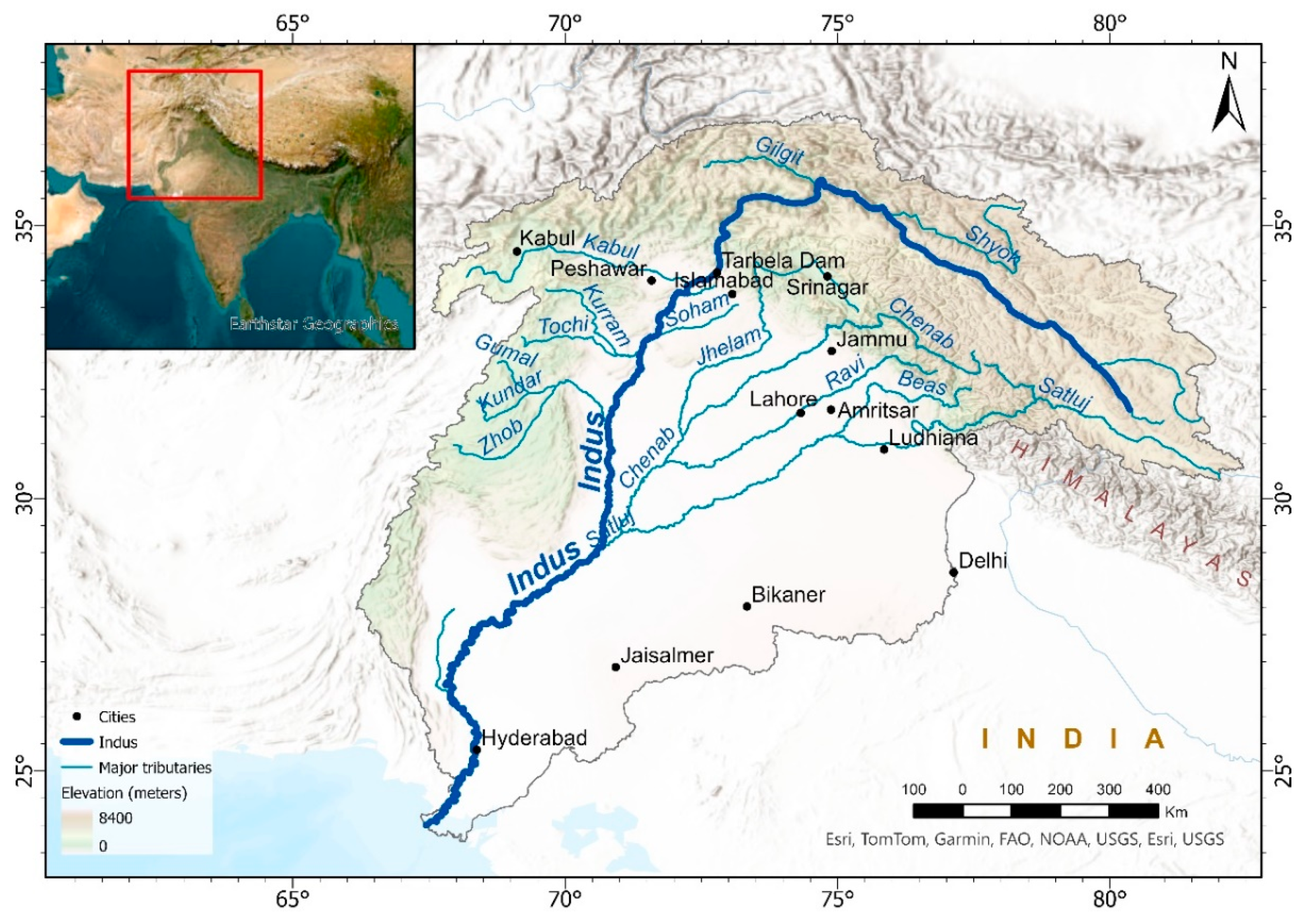
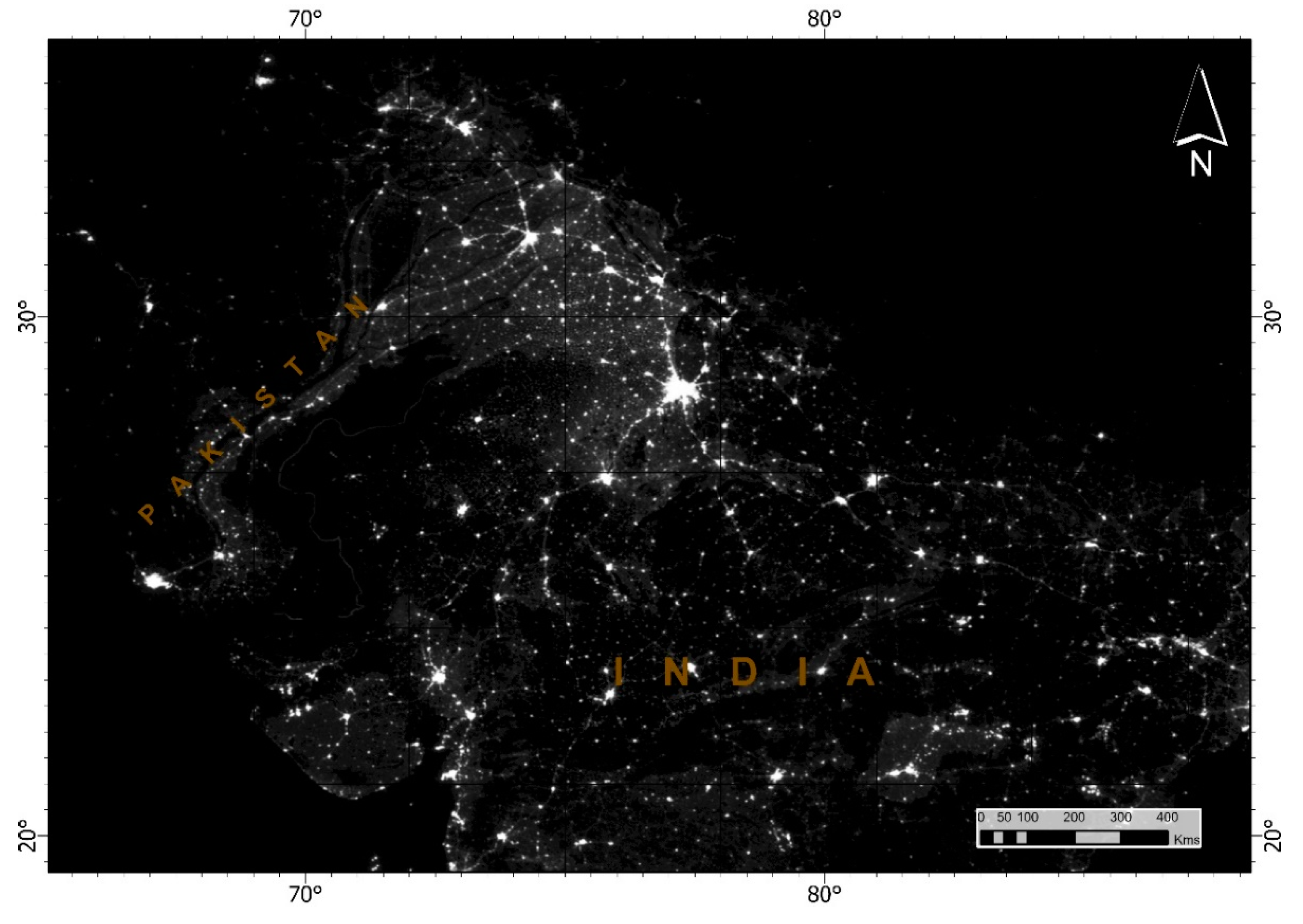
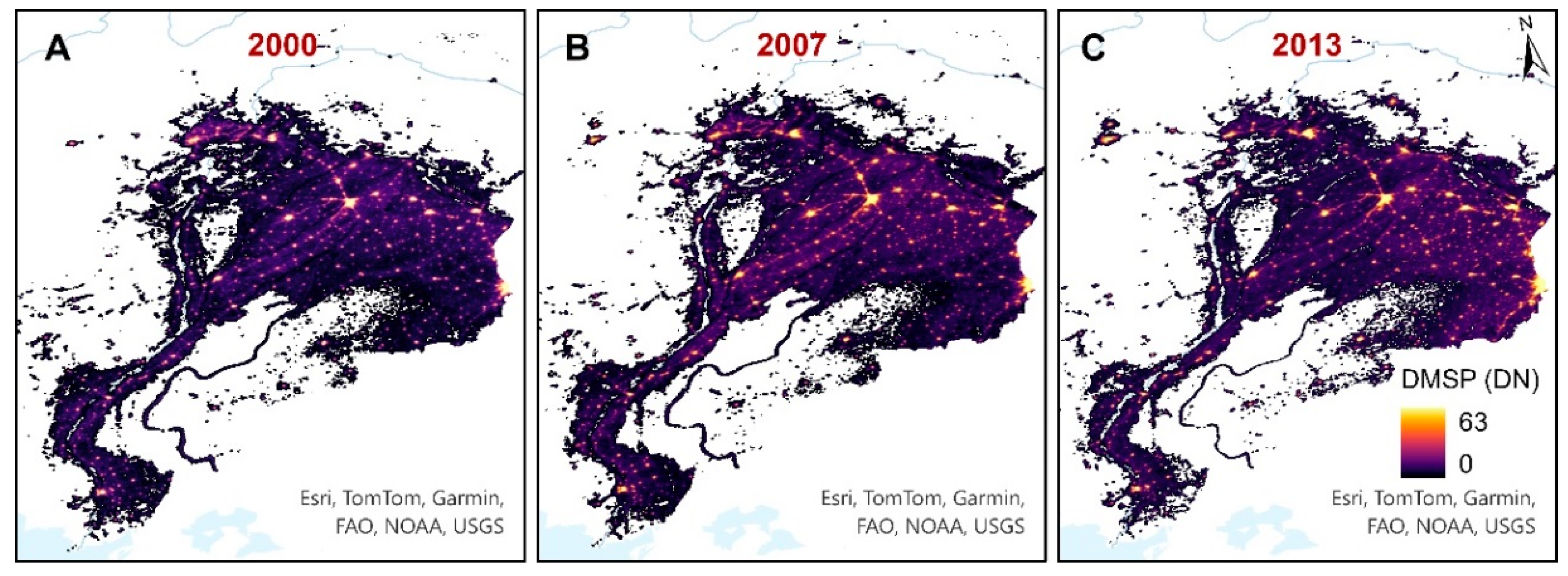
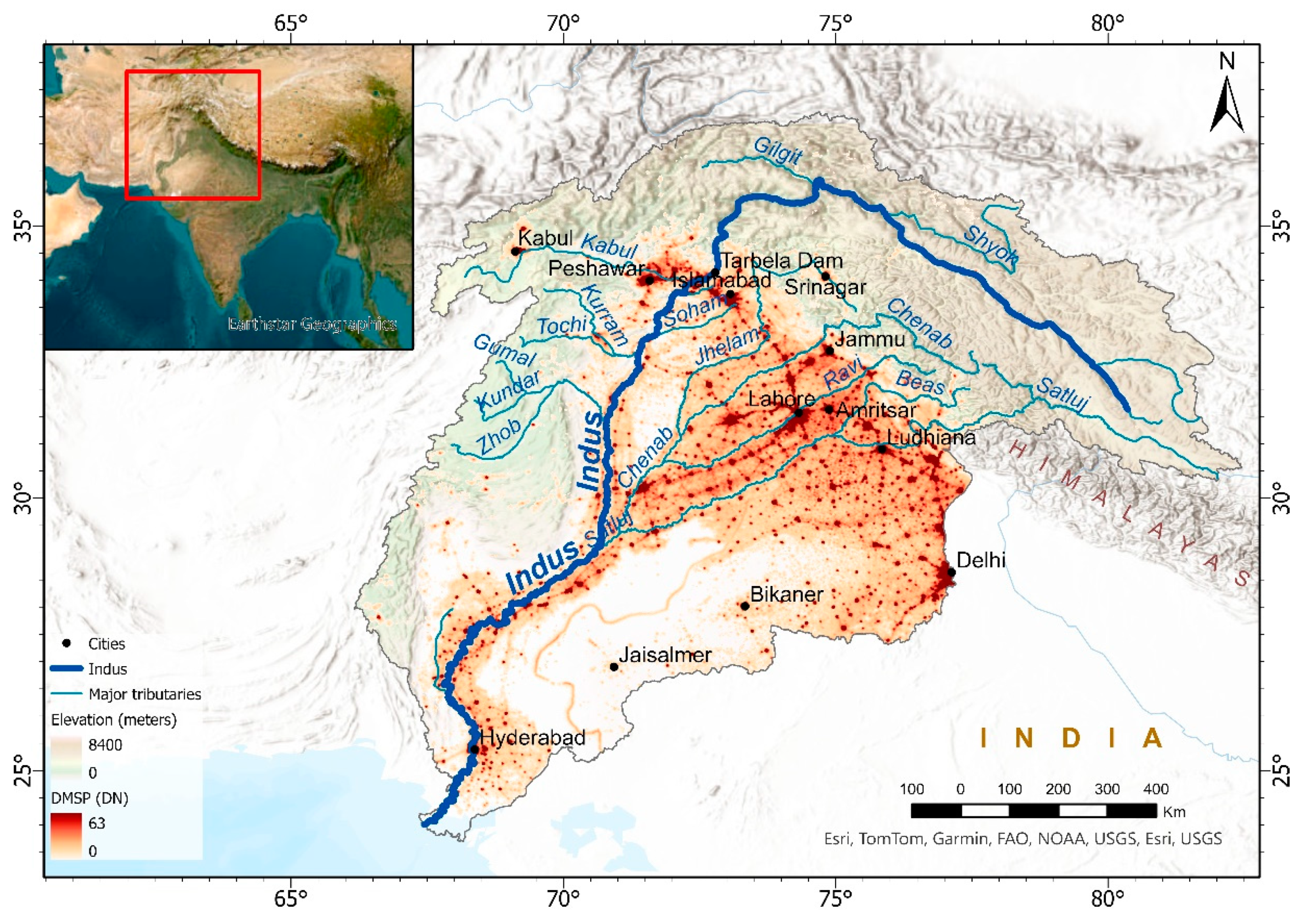

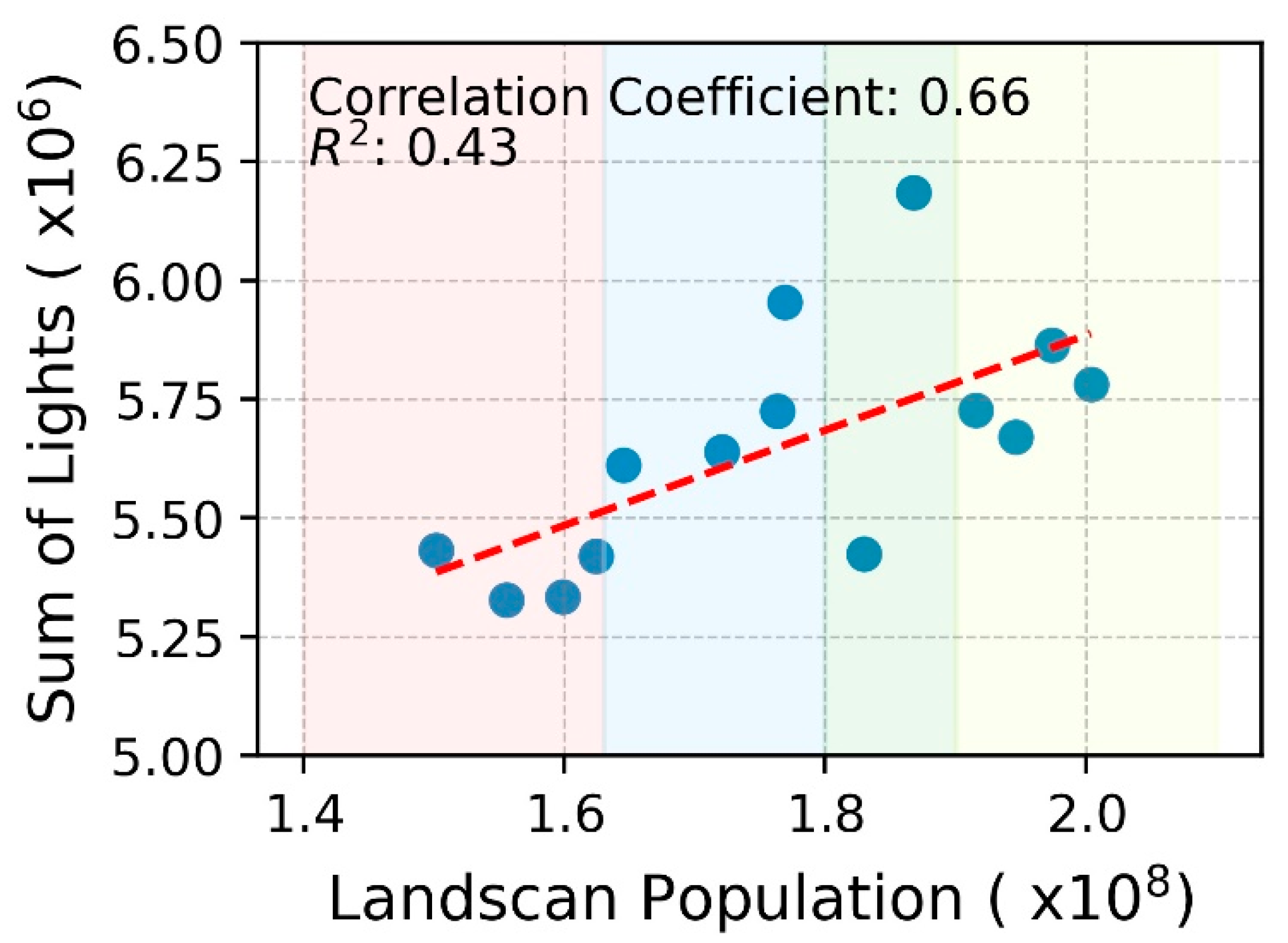
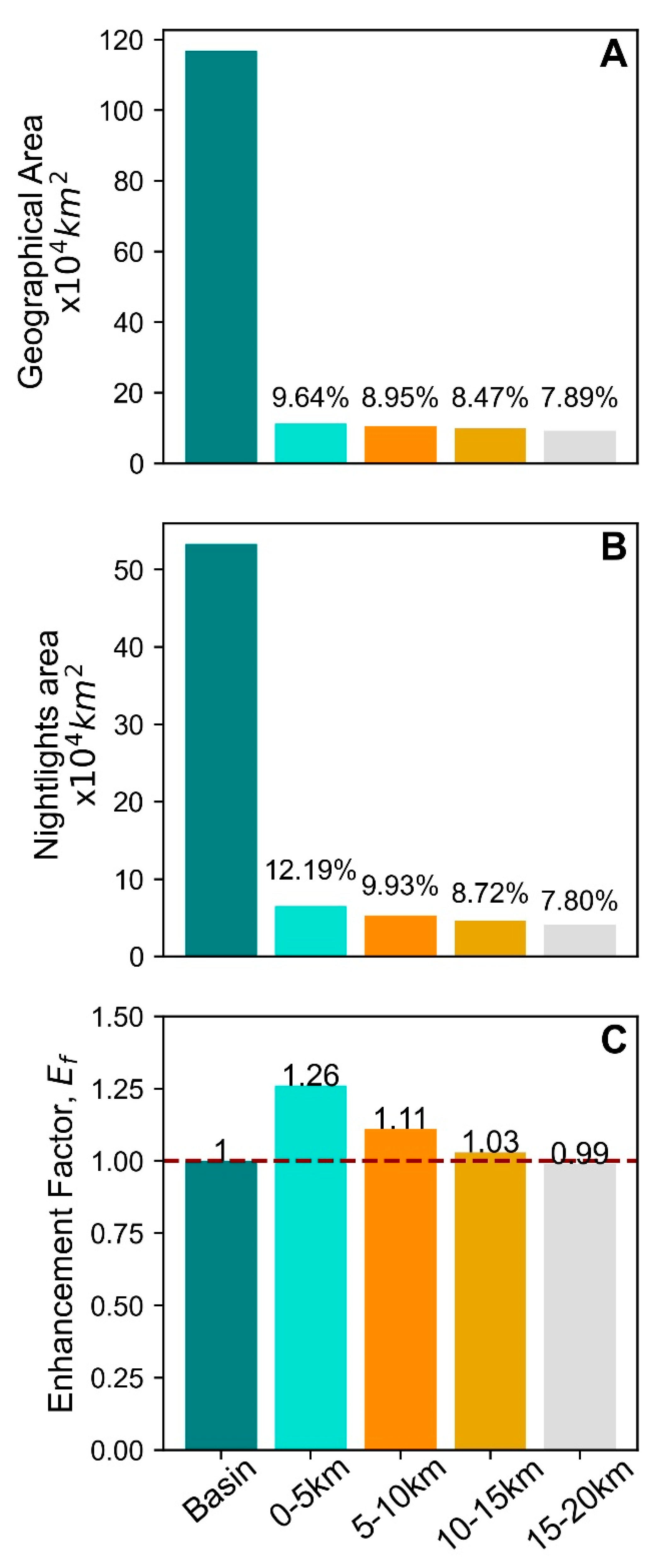
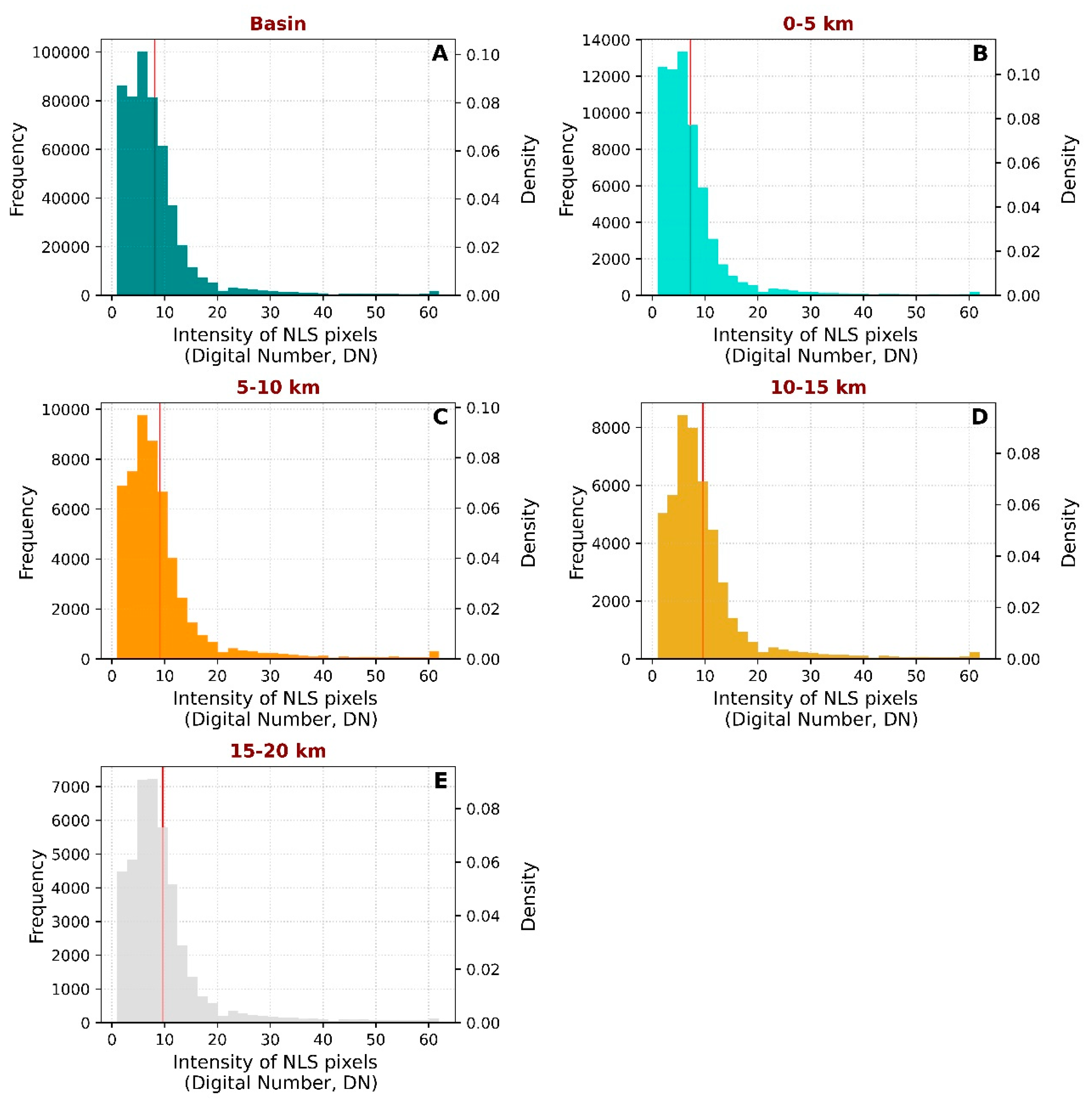
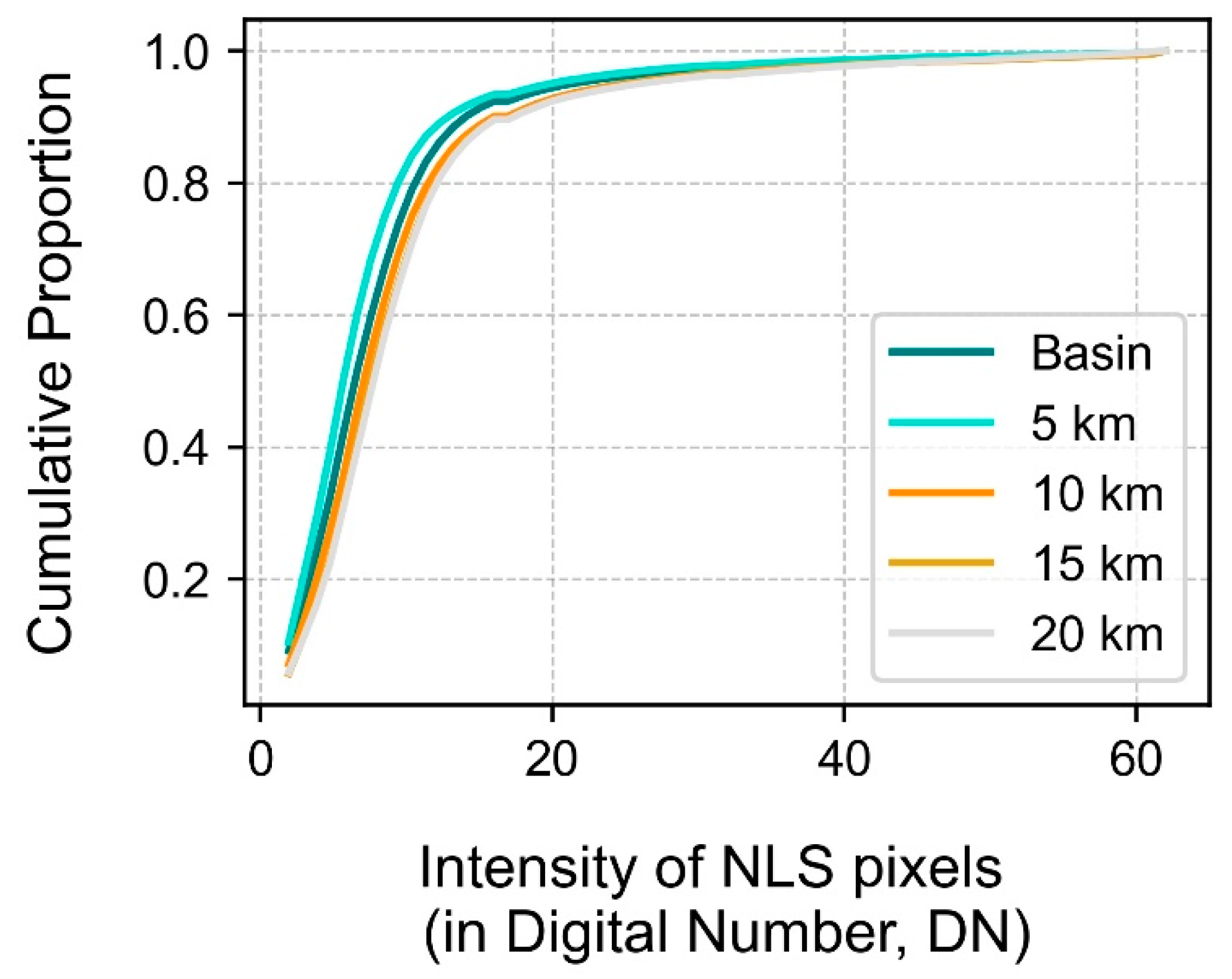
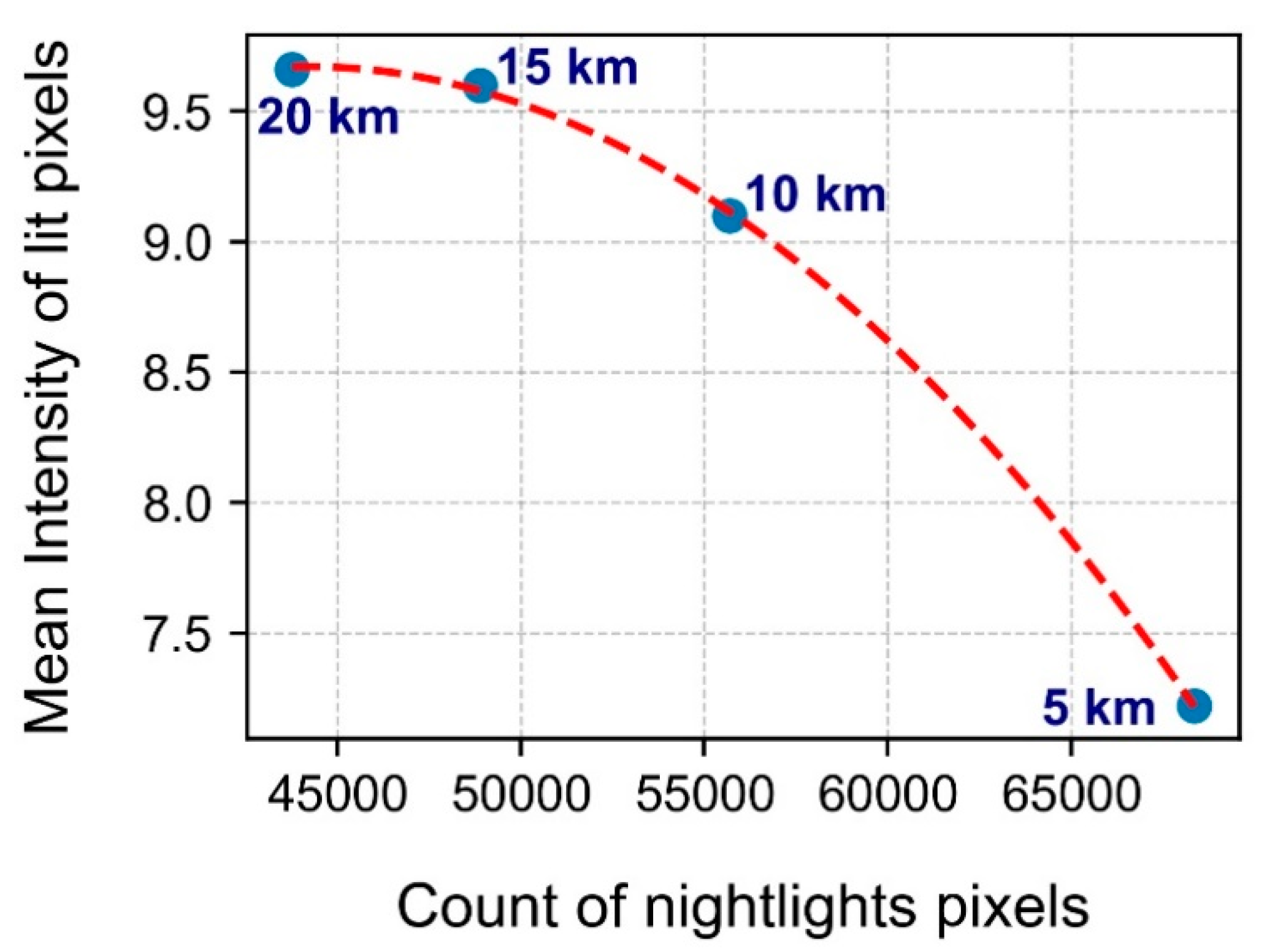
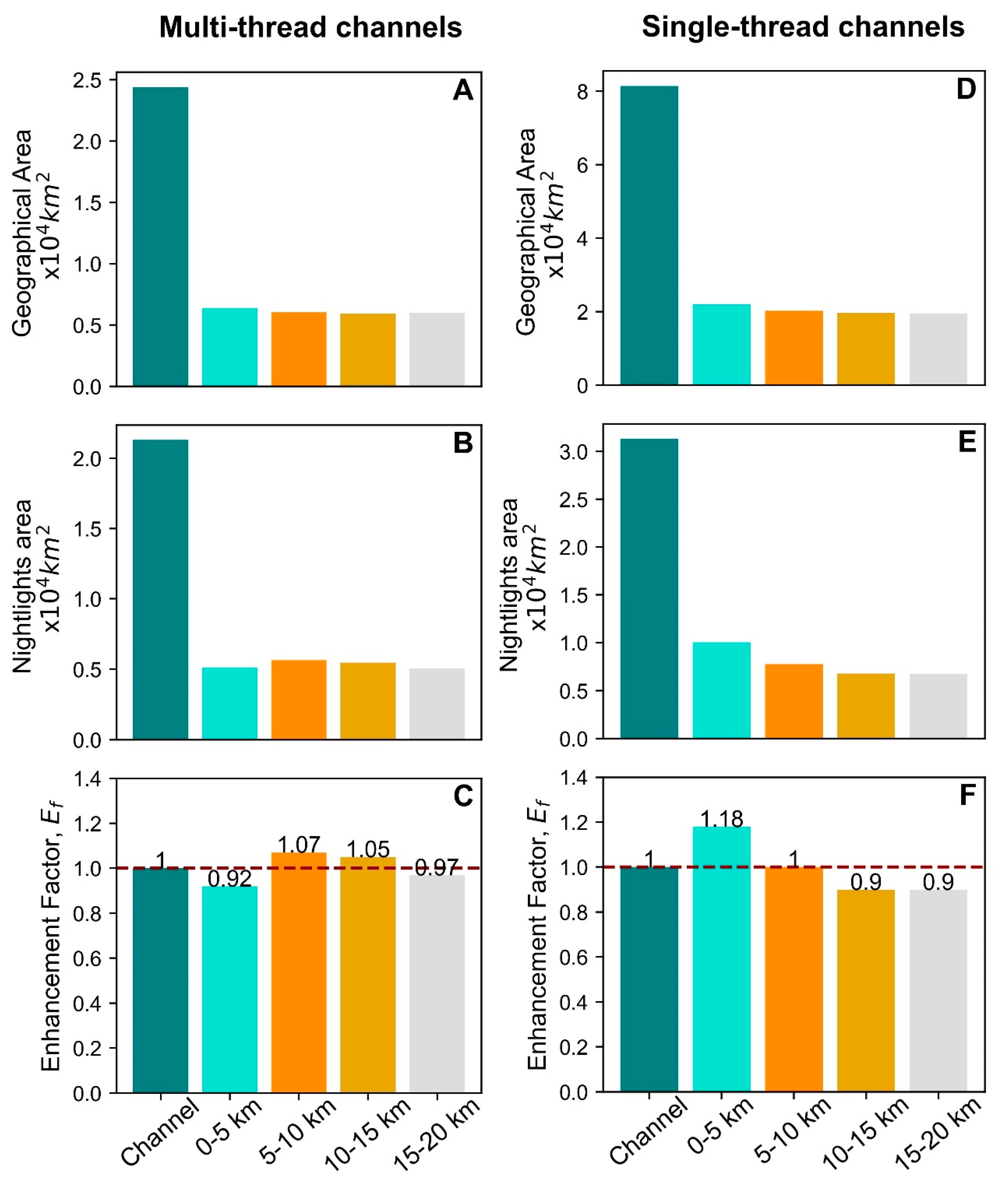
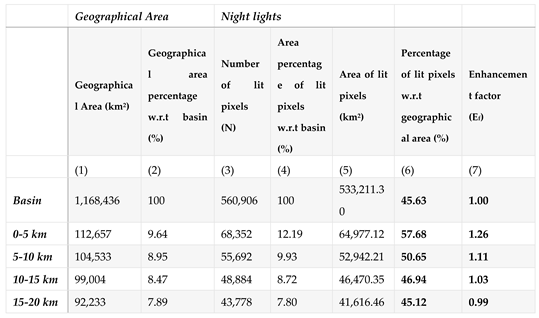 |
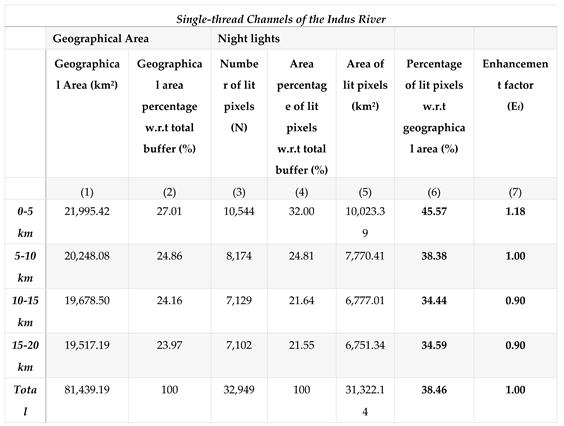 |
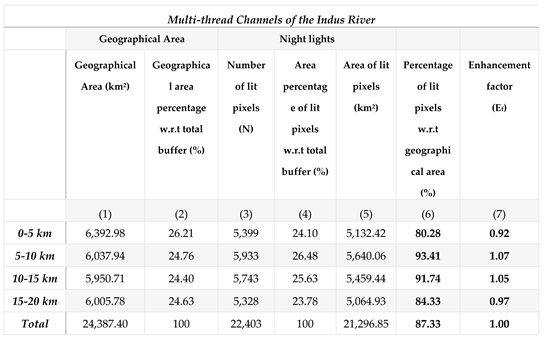 |
 |
Disclaimer/Publisher’s Note: The statements, opinions and data contained in all publications are solely those of the individual author(s) and contributor(s) and not of MDPI and/or the editor(s). MDPI and/or the editor(s) disclaim responsibility for any injury to people or property resulting from any ideas, methods, instructions or products referred to in the content. |
© 2024 by the authors. Licensee MDPI, Basel, Switzerland. This article is an open access article distributed under the terms and conditions of the Creative Commons Attribution (CC BY) license (http://creativecommons.org/licenses/by/4.0/).




